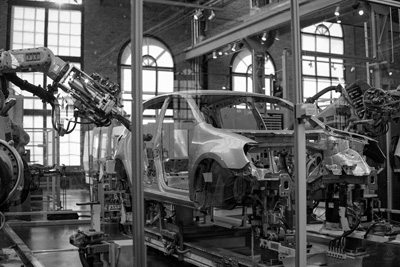Viability of a motor vehicle assembly in Sri Lanka
A newspaper recently carried an article stating that Minister Wimal Weerawansa had said that Toyota was interested in setting up a motor vehicle assembly plant in Sri Lanka; so long as the Government gave an assurance that the import restriction that is currently applicable be enforced for a period of 10 years.

File picture of an overseas assembly plant.
The purpose of this article is to argue that the assembly of motor vehicles with Internal Combustion Engines (ICE) in Sri Lanka is not economically sustainable, nor justifiable. However, the assembly of Electric Vehicles (EVs) is justifiable.
Insufficiently small domestic market
A CKD (Completely Knock Down) plant is quite capital intensive, as it entails significant manufacturing on site. In the context of the present level of automation in automotive manufacture, where welding is robotised, and the quality of the finished product requires this level of precision, the Sri Lankan domestic market is just not big enough to justify this level of investment.
Cost of SKD
The next level of assembly is SKD (Semi Knock Down), where the required capital and infrastructure is very much lower. The cost efficiency of automotive manufacture in an automated plant is such that most manufacturers find it cheaper to allow a vehicle to be fully assembled on their automated line, and then be dismantled prior to shipment. Most often, this dismantling is done outside of the main manufacturing plant.
Because the SKD vehicle has been assembled and then dismantled, it is often 20-30 per cent more expensive than the identical vehicle in CBU form.
Potential for local value addition
Apart from automotive batteries and tires, the capacity of the local industry to produce automotive components is limited. Further, the actual local value addition to the national economy is limited as most of the required inputs are imported.
It may be more viable for rubber component manufacturers and other potential automotive component manufacturers to seek the assistance of the Export Development Board (EDB), which is presently functioning with significant dynamism, to seek entry into export markets. India, Germany and the UK are significant exporters of automotive products. Our custom could be leveraged by the EDB to promote our automotive component suppliers to the international manufacturers of these countries.
Assembly of EVs viable
An ICE has over 40,000 moving parts and most parts are designed for the specific automotive model it is used in. An EV has only 17 moving parts. The main components of an EV are the battery, the motor and the controller. The cost of the battery comprises around 70 per cent of an EV.
The motor, the battery and the controller are homogenous and are manufactured by specialists. For example, Panasonic is a leading battery manufacturer, and many EV manufacturers use Panasonic batteries. An EV is designed around its battery; which often forms the undercarriage of the vehicle. This makes an EV more easily and economically adaptable to the process of SKD assembly.
Manufacture of Lithium Ion (LI) batteries
Another area that Sri Lanka could, and should, evaluate is the manufacture of LI batteries. These batteries are the heart of an EV and also form a significant part of many other components in our daily lives. For example, mobile phones, cameras, wrist watches and so on. Sri Lanka has deposits of graphene which is a raw material for LI batteries.
Minister Weerawansa was right in exploring local assembly of mobility products. All industry experts agree that the future of mobility lies in EVs. Mobility will also be connected, shared, and autonomous. By manufacturing LI batteries, Sri Lanka can manufacture the most vital component of future mobility and be a dominant entity in this ecosystem.
(The writer is a Co-Founder of Innosolve Lanka (Pvt.) Ltd, a start-up dedicated to introducing sustainable mobility solutions in Sri Lanka).


